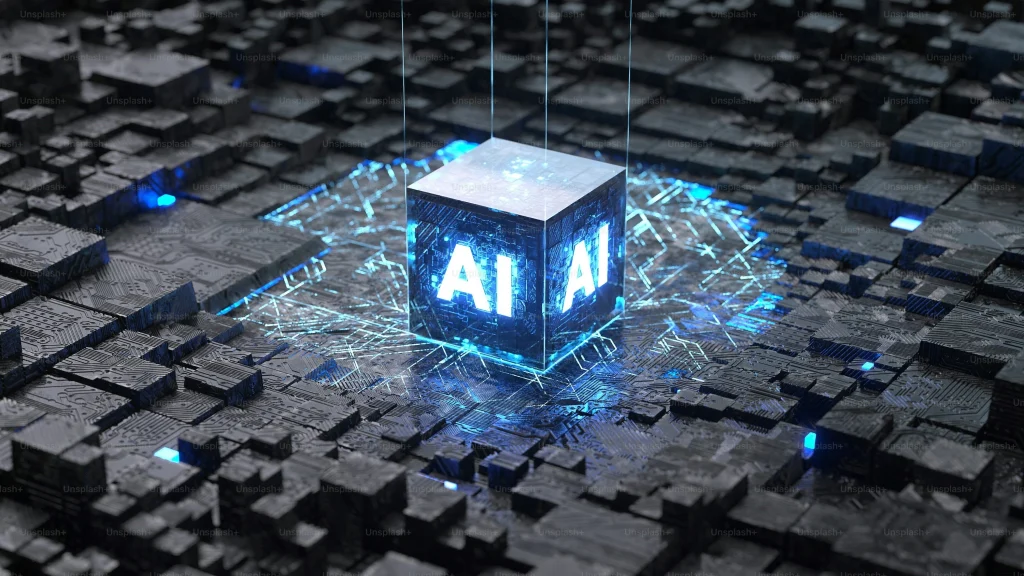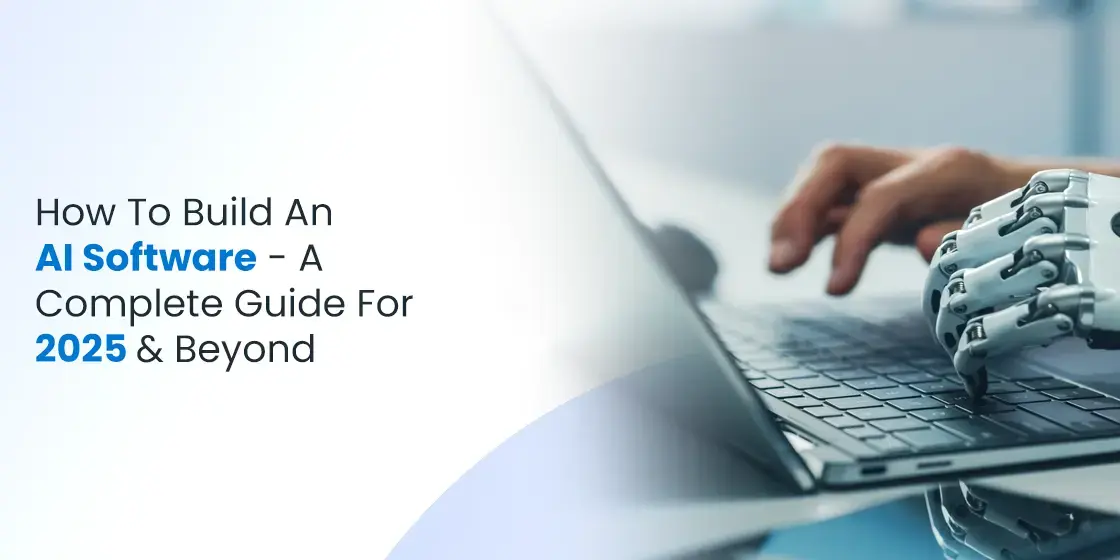Table of Content
Discover How to Make an AI-Based Software Solution for Businesses Today
Artificial Intelligence (AI) has rapidly evolved from a futuristic concept to a tangible reality, reshaping industries and transforming the way we live and work. AI-powered software has the potential to revolutionize businesses, streamline operations, and create innovative solutions. However, building an AI software requires a deep understanding of AI concepts, technical expertise, and a strategic approach. So the question is how to build AI software for your business that has never done so before?
AI, a broad field encompassing various techniques and technologies, has its roots in the desire to create intelligent machines that can mimic human intelligence. Machine Learning (ML), a subset of AI, enables systems to learn from data and make predictions or decisions without explicit programming. Natural Language Processing (NLP) is another crucial area of AI, allowing machines to understand and process human language. Large Language Models (LLMs) are powerful AI models capable of generating human-quality text, translating languages, and writing different kinds of creative content.
In this guide, we will explore the steps involved in building an AI software, the challenges you may encounter, and the best practices followed by professional enterprise software development agencies that ensure success.
AI, ML, NLP, LLM, and More – Understanding These AI Terms and More

To build an effective AI software, it’s essential to understand the fundamental concepts of AI, ML, NLP, and LLMs. These terminologies are important if you are to understand the role of AI in software development today.
- Artificial Intelligence (AI): The broader field of simulating human intelligence in machines. AI encompasses various techniques, including machine learning, natural language processing, computer vision, and robotics.
- Machine Learning (ML): A subset of AI that focuses on developing algorithms that allow computers to learn from data without explicit programming. ML techniques, such as supervised learning, unsupervised learning, and reinforcement learning, are used to train models to recognize patterns, make predictions, and automate tasks.
- Natural Language Processing (NLP): A field of AI that focuses on the interaction between computers and human language. NLP techniques enable machines to understand, interpret, and generate human language, enabling tasks like sentiment analysis, text summarization, and machine translation.
- Large Language Models (LLMs): A type of AI model trained on massive amounts of text data, capable of generating human-quality text, translating languages, writing different kinds of creative content, and answering your questions in an informative way. LLMs have revolutionized natural language processing and are used in a variety of applications, from chatbots to content generation.
What Are Some Common Types of AI Software You Can Build Today?

When we talk about how to make an AI software applicable to a wide variety of businesses, we see numerous examples of the artificial intelligence phenomenon in the industry today. Some common types include:
- Predictive Analytics: AI models can analyze historical data to predict future trends and outcomes. This can be used to forecast sales, identify potential risks, and optimize business decisions faster than manual processes, showing how AI transforms business forecasting.
- Chatbots and Virtual Assistants: AI-powered chatbots and virtual assistants can provide customer support, answer queries, and guide users through tasks, such as scheduling appointments, making reservations, or troubleshooting issues.
- Recommendation Systems: These systems utilize AI algorithms to analyze user behavior and preferences to recommend products, movies, music, and other content, increasing customer satisfaction and driving sales.
- Image and Video Analysis: AI can be used to analyze images and videos for object recognition, facial recognition, and content moderation. This technology is used in various applications, including security surveillance, medical image analysis, and autonomous vehicles.
- Autonomous Systems: AI-powered systems can operate autonomously, such as self-driving cars, drones, and robots. These systems rely on sensors, AI algorithms, and machine learning to perceive their environment and make decisions.
Why Should You Opt for AI Software Over Traditional Software

AI software offers several advantages over traditional software. When we talk about enterprise AI software systems, the addition of artificial intelligence helps to streamline and improve the efficacy of traditional, manpowered systems. With the purpose of making the organization more productive, these AI software systems include:
- Automation of Repetitive Tasks: AI can automate routine tasks, freeing up human workers to focus on more strategic and creative work.
- Personalization of Experiences: AI-powered systems can personalize user experiences, leading to higher customer satisfaction.
- Improved Decision-Making: AI-powered systems can analyze large amounts of data to provide valuable insights and inform decision-making.
- Enhanced Customer Experience: AI-powered chatbots and virtual assistants can provide 24/7 customer support, leading to improved customer satisfaction.
- Increased Efficiency: AI can streamline processes, reduce errors, save costs, and improve overall efficiency.
- Innovation: AI can enable the development of innovative products and services, giving businesses a competitive edge.
How to Make AI Solution – What Do you Need Before That?

Before embarking on your AI project, you need to consider the following elements in order to succeed:
- A Clear Problem Statement: Clearly define the specific goals and outcomes you want to achieve with your AI solution. This will help you focus your efforts and measure success.
- A Strong Team: Assemble a team with expertise in AI, machine learning, and data science. You will need AI experts, data scientists, and software engineers who have the expertise to build and deploy enterprise AI solutions.
- Quality Data: Gather and clean a large, diverse, and high-quality dataset to train your AI model. Data quality is crucial for the accuracy and performance of your AI system. Data quality is considered one of the biggest hurdles in AI adoption and advancement today.
- Computational Resources: Ensure access to powerful computing resources, such as GPUs or cloud-based platforms, to handle the computational demands of AI training and inference.
- AI Tools and Frameworks: Utilize popular AI frameworks like TensorFlow, PyTorch, and Scikit-learn.
- Budget: Allocate sufficient budget for data acquisition, development, deployment, and ongoing maintenance.
What Major Challenges are Faced By Organizations Looking to Create an AI System

Building an AI system can be challenging due to several factors, including:
- Data Quality and Quantity: High quality and sufficient data is crucial for training AI models. However, acquiring and cleaning large, high-quality datasets can be time-consuming and expensive.
- Model Complexity: Developing and training complex AI models can be computationally expensive and time-consuming.
- Ethical Considerations: AI systems must be developed and deployed ethically to avoid biases, discrimination, and unintended consequences.
- Talent Scarcity: Finding and retaining skilled AI talent can be challenging due to high demand and competition.
- Integration with Existing Systems: Integrating AI systems with existing legacy systems can be complex and time-consuming.
- Continuous Learning: AI models need to be continuously trained and updated to adapt to changing environments and data.
- Explainability: Understanding the decision-making process of AI models can be challenging, especially for complex models like deep neural networks.
How to Build an AI Software from the Ground Up – A Step-by-Step Guide

Now that you understand the pros and cons of AI software, you might be wondering how to build AI software for your business that avoids a lot of the challenges and pitfalls common to the practice. Therefore, by following the following steps curated by industry experts, and leveraging the power of AI, you can build innovative and impactful software solutions.
Let’s take a look at this AI software building process in greater detail.
Identify the Need for the AI and What You Expect from It
The first step in building AI software is to clearly define the problem you want to solve or the task you want to automate. Essentially, you will be looking at various artificial intelligence use cases to see what fits your scenario the best. This will help you focus your efforts and choose the appropriate AI techniques. Some common use cases for AI software include:
- Predictive Analytics: Forecasting future trends, such as sales, customer churn, or stock prices.
- Natural Language Processing (NLP): Analyzing and understanding human language, enabling applications like chatbots, sentiment analysis, and language translation.
- Computer Vision: Recognizing and interpreting visual information from images and videos, enabling applications like facial recognition, object detection, and image classification.
- Recommendation Systems: Recommending products, movies, or music based on user preferences and behavior.
Once you’ve identified your use case, you can start to think about the specific AI techniques you’ll need to implement. For example, if you’re building a chatbot, you’ll need to use NLP techniques to understand and respond to user queries. If you’re building a recommendation system, you’ll need to use machine learning techniques to analyze user data and identify patterns.
Collecting and Preparing the Required Dataset to Train and Test Your AI Model
A high-quality dataset is crucial for training an effective AI model. Here are the key steps involved in collecting and preparing your dataset:
- Data Collection: Gather relevant data from various sources, such as public datasets, APIs, or your own data sources.
- Data Cleaning: Clean the data to remove noise, inconsistencies, and missing values. This may involve techniques like data imputation, normalization, and outlier detection.
- Data Preprocessing: Preprocess the data to make it suitable for training AI models. This may involve tasks like feature engineering, feature scaling, and data augmentation.
- Data Labeling: If you’re working with supervised learning, you’ll need to label your data with the correct outputs. This can be a time-consuming process, but it’s essential for training accurate models.
- Data Splitting: Split the dataset into training, validation, and testing sets to evaluate the model’s performance.
Choose the Desired Platforms and Tools to for Your AI-Based Tool
When you talk about how to build AI software for business or other purposes, one of the first things people ask you is the platform and tools you are going to use for it. Selecting the right tools and frameworks is crucial for efficient AI development. Some popular options include:
- Machine Learning Frameworks: TensorFlow, PyTorch, Scikit-learn
- Cloud Platforms: Google Cloud Platform, Amazon Web Services, Microsoft Azure
- Data Science Tools: Jupyter Notebook, Pandas, NumPy
- Deep Learning Frameworks: TensorFlow, PyTorch, Keras
Choose the Type of AI Model and the Algorithm You Want to Base it On
The choice of AI model and algorithm depends on the specific problem you’re trying to solve. Here are some common types of AI models and algorithms:
- Supervised Learning: Used for tasks like classification and regression. Algorithms include linear regression, logistic regression, decision trees, random forests, and support vector machines.
- Unsupervised Learning: Used for tasks like clustering and dimensionality reduction. Algorithms include k-means clustering, hierarchical clustering, and principal component analysis.
- Reinforcement Learning: Used for training agents to make decisions in a dynamic environment. Algorithms include Q-learning and deep Q-networks.
- Deep Learning: A subset of machine learning that uses artificial neural networks to learn complex patterns from large datasets. Deep learning is used for tasks like image and speech recognition, natural language processing, and computer vision.
Train the Model On Your Prepared Dataset
Training an AI model involves feeding the prepared dataset into the chosen algorithm and iteratively adjusting the model’s parameters to minimize the error between the predicted output and the actual output. This process is often referred to as model optimization. Key considerations during training include:
- Hyperparameter Tuning: Experiment with different hyperparameters, such as learning rate, batch size, and number of epochs, to optimize model performance.
- Regularization: Techniques like L1 and L2 regularization can help prevent overfitting.
- Early Stopping: Stop training when the model’s performance on the validation set starts to degrade.
Test and Evaluate the Performance of Your AI Model
Once the model is trained, it’s important to evaluate its performance on a validation dataset. This helps assess the model’s accuracy, precision, recall, and other relevant metrics. If the performance is not satisfactory, you may need to adjust the model’s hyper parameters, collect more data, or choose a different algorithm. Common evaluation metrics used in AI software testing strategies include:
- Accuracy: The proportion of correct predictions.
- Precision: The proportion of positive predictions that are actually positive.
- Recall: The proportion of actual positive cases that are correctly identified.
- F1-score: A harmonic mean of precision and recall.
- Confusion Matrix: A table that summarizes the performance of a classification model.
Deploy your AI Model into Your Software
Deploying the trained model involves integrating it into your software application or web service. This may involve creating APIs, deploying the model to a cloud platform, or embedding it directly into your application. This can be done using various techniques, such as:
- Model Serialization: Saving the trained model to a file format that can be loaded later.
- Model Deployment Platforms: Using platforms like TensorFlow Serving or MLflow to deploy models as REST APIs.
- Cloud-Based Deployment: Deploying models to cloud platforms like GCP, AWS, or Azure for scalable and efficient deployment.
When deploying your model, consider the following critical factors:
- Model Serving: Choose a suitable framework or platform for serving the model, such as TensorFlow Serving, TorchServe, or a cloud-based solution.
- API Integration: Create APIs to expose the model’s functionality to other applications or services.
- Deployment Environment: Deploy the model to a production environment, such as a cloud server or on-premises infrastructure.
- Monitoring and Maintenance: Continuously monitor the model’s performance and retrain it as needed to maintain accuracy and address evolving data patterns.
Thus, the process of how to make an AI software comes to a successful end. However, the process of monitoring and improvement will continue until you replace your AI model with something else. Thus, if we talk about this in project management terms, this is the stage where your AI software development project ends, and moves towards the operations team for continued monitoring and management.
Monitor It for Any Issues and If Needed, Update the Training Regularly
After deployment, it’s important to monitor the performance of your AI system and retrain it as needed. This can be done by tracking metrics like accuracy, precision, recall, and F1-score. Additionally, you can collect feedback from users to identify areas for improvement. It ensures that the model remains accurate and effective over time. You may need to retrain the model if the data distribution changes, or if the performance degrades.
Various types of AI software monitoring include:
- Performance Monitoring: Track key metrics, such as accuracy, precision, recall, and latency.
- Data Drift: Monitor for changes in the data distribution that could impact the model’s performance.
- Model Retraining: Re-train the model periodically to incorporate new data and improve its accuracy.
- Ethical Considerations: Ensure that the model is fair, unbiased, and does not perpetuate harmful stereotypes.
Choosing the Perfect AI Tools for Your AI Software

The choice of AI tools depends on various factors, including the complexity of the problem, the size of the dataset, and the team’s expertise. Some popular AI tools include:
- TensorFlow: A popular open-source platform for machine learning and deep learning.
- PyTorch: A flexible and user-friendly deep learning framework.
- Scikit-learn: A powerful machine learning library for classical machine learning algorithms.
- Keras: A high-level API built on top of TensorFlow and PyTorch, simplifying the development of deep learning models.
- Google Cloud AI Platform: A comprehensive platform for building, training, and deploying AI models.
- AWS SageMaker: A fully managed platform for machine learning, providing tools and services for data preparation, model training, and deployment.
- Azure Machine Learning: A cloud-based platform for building, training, and deploying machine learning models.
- OpenAI: A leading AI research lab offering APIs for various AI tasks, including language generation and image analysis.
- Amazon Web Services (AWS) and Microsoft Azure: Other cloud platforms offering a wide range of AI and machine learning services.
Top Tips and Best Practices for How to Build an AI Software Successfully

Now that you know and understand how to build AI software for an organization, you might be gearing up to create one for your own. However, as AI is still evolving quite quickly, novices in the industry can end up making mistakes that can cost them the entire venture.
With the right experience, tricks, and tips however, you can ensure that you at least avoid the bigger issues. Here are some of these top tips to guarantee your success in the Ai software arena.
- Start Small: Begin with a simple, focused project to gain experience and build confidence.
- Collaborate with Domain Experts: Involve experts from the relevant domain to ensure the AI solution aligns with business needs.
- Iterate and Experiment: Continuously iterate on your AI models and experiment with different techniques to improve performance.
- Prioritize Data Quality: Ensure the quality of your data to avoid biases and inaccuracies.
- Ethical Considerations: Develop and deploy AI systems ethically, considering factors like fairness, transparency, and accountability.
- Regularly Update and Maintain: Keep your AI models up-to-date and maintain them to ensure optimal performance.
Conclusion
Building AI software is a complex and challenging task, but with the right approach and tools, it is achievable. By following the steps outlined in this guide, you can develop powerful AI solutions that can drive innovation and transform your business. Remember to prioritize data quality, experiment with different techniques, and continuously learn and iterate to achieve success.
Empower your digital initiatives with BariTechSol, a premier custom software development company. Our skilled team tailors cutting-edge solutions to your unique needs. Elevate your tech experience and stay ahead in the digital realm. Partner with BaritechSol and code the success of your next big idea.


